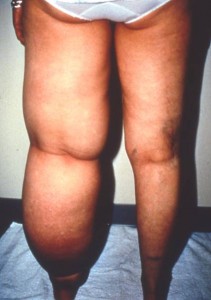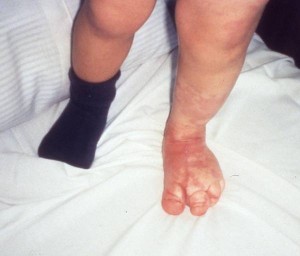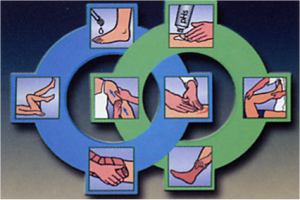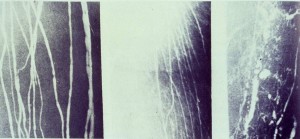While secondary lymphedema is caused by blockage or damage to a normally functioning lymphatic system resulting from surgery, radiation, trauma and other known insults, the formation of primary lymphedema is caused by pathology affecting the structure and function of the lymphatic system directly in form of a developmental abnormality, most commonly hypoplasia or hyperplasia involving lymph vessels and/or lymph nodes.
Hypoplasia, the most common malformation, refers to an incomplete development, that is, the number of lymph vessels and/or nodes is reduced, or the size of these lymphatic structures is smaller than normal.
Hyperplasia is generally associated with a structural malformation of lymph vessels and/or nodes (lymphangiectasia, or megalymphatics); enlargement (dilation) of lymph vessels in this case may result in a malfunction of valves located within the lymph collectors, compromising the flow of lymphatic fluid.
Lymphatic aplasia is rare and describes the absence of single lymph vessels and/or nodes, which may be the cause for the onset of primary lymphedema.
Primary lymphedema is far less common than the secondary form; it has been estimated to affect 1 in 100,000 people worldwide (1,5), predominantly in female patients with a ratio of one male to three females. In the majority of primary lymphedema cases, the lower extremities are affected.
Click here for a short video on the incidence of primary lymphedema
The maldevelopment of the lymphatic system in primary lymphedema is inherited, which means it can pass from generation to generation.
Several genes (VEGFR3, FOXC2, SOX18, ANGPT2, others) can be involved in the development of the lymphatic system (2) and mutations of any of these genes may cause lymphedema. However, only one of these genes is typically responsible for the lymphatic malformation in a particular family. Inherited lymphedema presents in an autosomal dominant pattern with incomplete penetrance and variable expression.
Primary lymphedema can also be associated with a known syndrome (Turner, Noonan, Hennekam, others).
What does that mean?
Except for genes on the sex chromosomes, both males and females have two copies of each gene. If only one altered copy of a gene (mutation) causes a malformation, the condition will be inherited in what is called a dominant pattern, which essentially means that children of parents with primary lymphedema have a 50% chance of inheriting the defective gene. This, however, does not explain why primary lymphedema is more common in female offspring; further studies will hopefully shed more light on this phenomenon.
 In genetics the strength of a gene is described as penetrance; a strong penetrance is present if all children who inherit the abnormal gene develop primary lymphedema. If only a fraction of children who inherit the abnormal gene actually develop the condition, the penetrance is described as inconsistent or variable. This is the case with the lymphedema gene; not all children who inherit the mutation will show evidence of lymphedema. In many cases of primary lymphedema it can be established that the condition skipped one or more generations.
In genetics the strength of a gene is described as penetrance; a strong penetrance is present if all children who inherit the abnormal gene develop primary lymphedema. If only a fraction of children who inherit the abnormal gene actually develop the condition, the penetrance is described as inconsistent or variable. This is the case with the lymphedema gene; not all children who inherit the mutation will show evidence of lymphedema. In many cases of primary lymphedema it can be established that the condition skipped one or more generations.
Variable expression indicates that the swelling may affect the left leg of one family member, another family member’s right foot, and yet another family member may have both legs involved.
In addition, the age of presentation can also be quite variable. Although the abnormalities in the development of the lymphatic system are present at birth, lymphedema may develop at any point later in life, most often during puberty or pregnancy with a peak in the onset between the ages 10 and 25. However, primary lymphedema may not visibly develop at all as long as the genetically compromised lymphatic system is sufficient enough to manage its workload.
 Primary lymphedema can be classified by the age of the patient at the onset of the swelling. Congenital (pediatric) lymphedema is present at birth or within the first two years of life and accounts for 10-25% of all cases of primary lymphedema. Boys typically are affected at birth, and girls most often present with lymphedema during adolescence (3). A sub-group of patients with congenital lymphedema has a familial pattern of inheritance, which is known as Milroy’s disease (VEGFR3 mutation) (4).
Primary lymphedema can be classified by the age of the patient at the onset of the swelling. Congenital (pediatric) lymphedema is present at birth or within the first two years of life and accounts for 10-25% of all cases of primary lymphedema. Boys typically are affected at birth, and girls most often present with lymphedema during adolescence (3). A sub-group of patients with congenital lymphedema has a familial pattern of inheritance, which is known as Milroy’s disease (VEGFR3 mutation) (4).
The most common form of primary lymphedema is termed lymphedema praecox, also known as Meige’s disease (no known gene mutation); by definition, it becomes clinically evident after birth and before age 35. This condition accounts for 65-80% of all primary lymphedema cases and most often arises during puberty or pregnancy.
A relatively rare form of primary lymphedema is when the first signs of swelling appear after 35 years of age; this condition is called lymphedema tarda.
Regardless of the cause, there is no cure for lymphedema. However, primary lymphedema can be very effectively managed, especially if it is diagnosed early. Individuals affected by lymphedema may encounter a number of problems, which can be either attributed to other pathologies (comorbidities) that may be present in addition to existing lymphedema and further exacerbate its symptoms, or secondary complications which may develop as a result of stagnated lymphatic fluid. Secondary complications are common to lymphedema, especially if the swelling is left untreated, and often contribute to the progression of the swelling.
Both early diagnosis and intervention of lymphedema are equally crucial for optimal treatment results. Whether lymphedema is caused by developmental abnormalities, or surgery/radiation to the lymphatic system, the possible long-term physical and psychosocial burden resulting from untreated or mistreated lymphedema can be serious.
Proper treatment is available, and the classification of lymphedema into primary and secondary has little significance in determining the method and goal of therapy. The goal of any treatment is to reduce the swelling and to maintain the reduction – that is to bring the lymphedema back to a normal, or near-normal size so affected individuals can continue with the activities of daily living, and to limit the risk of infection.
 The accepted gold-standard for the treatment of lymphedema is Complete Decongestive Therapy (CDT). Backed by long standing experience this therapy has shown to be safe and effective as the standard therapy for lymphedema. Click here to read more about CDT.
The accepted gold-standard for the treatment of lymphedema is Complete Decongestive Therapy (CDT). Backed by long standing experience this therapy has shown to be safe and effective as the standard therapy for lymphedema. Click here to read more about CDT.
Recent developments in research indicate that drugs are beginning to become available to oppose or correct the effects of gene mutations (6, 7).
Dear Lymphedema Blog Reader – if you like the contents on this website, please help to keep it going. A great amount of work and research is necessary to provide you with up-to-date information on this site. Your donation supports these efforts and associated administrative costs. Surplus funds will be donated to Lymphedema/Lipedema-related charitable endeavors. Please donate using the “Donate Now” button on the right upper hand of this page – Thank You!
Join Lymphedema Guru, a Facebook page solely dedicated to informing about all things related to lymphedema – news, support groups, treatment centers, and much more
References:
- http://jmg.bmj.com/content/22/4/274.full.pdf
- https://pubmed.ncbi.nlm.nih.gov/18564921/
- http://www.ncbi.nlm.nih.gov/pubmed/21617474
- http://ghr.nlm.nih.gov/condition/milroy-disease
- https://www.frontiersin.org/articles/10.3389/fphys.2020.00137/full
- https://pubmed.ncbi.nlm.nih.gov/34112235/
- https://pubmed.ncbi.nlm.nih.gov/29461977/
Video:
Primary Lymphedema: How Science Has Changed Patient Care – Dr. Peter Mortimer
Further Reading:
http://www.lymphnet.org/pdfDocs/nlntreatment.pdf
http://www.ncbi.nlm.nih.gov/pmc/articles/PMC1287178/
http://www.ncbi.nlm.nih.gov/pubmed/9817924
http://adc.bmj.com/content/71/1/44.full.pdf
http://plasticsurgerynotes.net/Lower_Extrimity/lymphatic_disorders.asp
http://www.hgen.pitt.edu/projects/lymph/inheritance.php
http://emedicine.medscape.com/article/191350-overview#a0102
http://www.lymphedemapeople.com/thesite/primary_lymphedema.htm
http://www.medicinenet.com/lymphedema/article.htm
http://www.noblemed.com/primary.htm
http://www.ncbi.nlm.nih.gov/pubmed/18564921y
http://www.ncbi.nlm.nih.gov/pubmed/6843174


 Joachim Zuther, Lymphedema Specialist.
Joachim Zuther, Lymphedema Specialist. 


Another great and informative article Joe, our thanks to you!!! I would like add a couple items, if I might. We have children in our children’s group who are actually the proband of lymphedema in their families. Proband, of course meaning the first one to show that genetic mutation you mentioned. Also, if there is a reason to rejoice with lymphedema, the genetic defect responsible can (depending on penetrance) gradually fade away, as it were. My generation was slammed by LE. Only 1 in our cihldrens generation shows LE and none thus far in their children’s generation. So, hopefully our LE gene is fading away. Thanks again for all you do to help. Pat
Dear Pat: Thank you for your valuable comments on this topic. I do have a couple of primary cases, which show no signs of lymphedema in several generations. As always, thank you so much for all the great work you do for the lymphedema community!
Hi Mr.Joachim,
I am Mr. Haroun from Algeria, I have primary Lymphedema in my right leg since 1984, but it’s not a genetic problem.
I had sought treatment in France, many years ago but the treatment had little success. In my correspondence with Hospitals last year, and with chance
I chose Abbott Northwestern Hospital in Minneapolis, Minnesota,they sent me an appointment to do more tests and learn more about the diagnosis for my leg.
I had therapy for six weeks in Sister Kenny Clinic and surgery the type of surgery was called radiofrequency ablation on my greater sapphenous vein.
Now I feel better because my swelling is continuing to decrease with bandaging and using velcro garment everyday .
Please I need your email address just to ask you about my future treatment.
Email:haron1971@hotmail.com
best regards
Haroun
Dear Mr. Haroun: May I refer you to an article I wrote on Filariasis, which you may find helpful. There are a number of links at the bottom of the article, that may be of interest to you: https://www.lymphedemablog.com/2011/11/04/what-is-lymphatic-filariasis/
Goodmorning Mr.Joachim
I am Mr.Haroun from Algeria and I have lymphedema leg, please I need favor from you to delete all my messages .
because I receive emails everyday.
best regards
Haroun
It is nice to see some information about primary lymphedema. As the only person in my family with lymphedema tarda I think mine comes from a birth defect. My left side of my face was under developed and I was born with a wry neck. Lymphedema was never mentioned as something that could develop. When I developed it I was 50 and it took nearly 3 years to get a diagnosis.
I think what I am trying to say is we need doctors to be better informed about lymphedema. I have been informed by a massage therapist that I should not have any pain. I know I have pain and I have friends with secondary lymphedema that have pain as well.
Is it just primary or do folks with secondary also have to deal with pain. Is it possible that some cases of lymphedema that develop after surgery are actually primary tarda?
I really enjoy your comments and find out a great deal from your Facebook page.
Dear Willa: Yes, some cases of post surgery lymphedema may develop due to a pre-existing malformation of the lymphatic system. The surgery is then the trigger to cause the onset of swelling.
GREAT article. My son, 4 years old was born with a face/lip/neck microcystic lymphedema and thanks to the Decongestive Therapy he is no longer needing antibiotics every time that he gets an infection!
Everyone should try the therapy before surgery, I wish I knew about it before my son’s surgery.
Hi Dear Joachim,
Thank you so much for information about Lymphatic Filariasis .
But me I was born normal and after 12 years,my right leg became to change “MUTATION” and it is not filariasis because the blood result test was positive without infection microfilariae .
I mean I was born without lymphnodes in my right leg as My Dr.Nancy A.Hutchison,MD said to me in appointment in Abbott NorthWestern Hospital last summer.
few years ago I had appointment with Dr.Foeldi and I tried to come to Foeldi Clinic but I hadn’t enough money and they know me very well and it was my dream.
My French medical file is in Clinic Foeldi.
best wishes
Haroun
My son was born with lymphedema in his left foot. He is 12 yrs old now and it has moved to the lower half of his body. Is there anything else I can do for him?
Dear Konnie: If you son was diagnosed with lymphedema, I would suggest you consult with a trained lymphedema therapist. You can look up therapists in your area by clicking on the “Find a Therapist” button on the top of this page.
We have one at Mission Hospital. I was just wondering if there was anything new out there. I also have a half sister and her son has lymphedema as well….
This is the first time that I have know this condition. Thanks for the pics, as it really shows what the condition can do to a person’s body.
i have priomary lymphedema with scrotum and penis swelling. now i am married but not conceiveing a baby. i want to know that is it a common problem in primary lymphedema of male that his wife cant get pregnanat .note my wife is not effected with lymphedema
While it is not established that male genital lymphedema can cause infertility, there are some reports suggesting a relation (http://www.lymphedemapeople.com/wiki/doku.php?id=male_genital_lymphedema).
Please note that genital lymphedema can be brought under control with CDT. In the new edition of the book “Lymphedema Management” are self-help guidelines for this condition, which you may find very helpful.
Kind regards,
Joe Zuther
ihave with primery limphodima when iwas born so plese suggest me for best therepist in india an iwant to your advice thanks col.91 9414182373
Please go to the following link in order to locate a therapist in India: https://www.lymphedemablog.com/find-a-therapist/
HI: I am 68 and have had primary lymphedema for 52 years at the same time I began taking thyroid medication. I now have lymphedema in my feet, legs, thighs, bottom, belly, and neck. I like the lymph drainage which I have had but it didn’t include all these areas. Is there anything new I could be doing to help myself? We have NO lymphedema doctors in Edmonton, Canada. Thanks. Helen
Dear Helen: Complete Decongestive Therapy is the treatment of choice for lymphedema. One of the largest schools to train lymphedema therapists is located in Canada, the Vodder School. I would suggest contacting this school in order to locate a therapist in your area. Here is a link to an article you may find helpful: https://www.lymphedemablog.com/2012/07/03/complete-decongestive-therapy-in-the-treatment-of-lymphedema/
I have LE from birth. I’m 26 yrs now. I only started using compression stockings this year and have not really seen any meaningful result haven used it for about 4months.. Pls how can I connect with a specialist in Nigeria.
[…] Primary Lymphedema and Secondary Lymphedema usually progress through a series of stages. That’s why it’s important […]
Hi! I’ve had primary Lym. Since age 12. The more surgeries to diagnose the bigger it got. Wear mobster stocking and elevate every nite. Keep weight down and exercise. Now am getting small cancers or some kind of sores on it, mostly front. Drs nervous about biopsy. Using chemo screams. Is this common? Not sure how to continue. Any advice would be helpful. Live in Crestline Calif.
Dear Jill: I am unable to give any advise in this case; this is an issue your PCP/oncologist needs solve.
Thank you for this information. I developed lymphedema while pregnant with my first child. It was over twenty years before I finally found a doctor who knew there was something I could do about this problem. Keep getting the word out there so physicians don’t treat people with condescension and disdain. I prefer therapy and leg wraps.
I have primary lymphedema in both legs below the knee. I am a pretty active person and i try my best to follow my diet.I am currently working on loosing weight for the Military. I am wondering is this the best decision by joining the military being that i have primary lymphedema.If so what are some suggestion you have for me to keep my swelling under control while pursuing this.
P.S. I have had primary lymphedema since 3 months
I just happened to be searching for primary lymphedema complications and stumbled across your site..My mother had it mostly in her right foot/ankle and then my older brother and sister (twins) were born with and it never got better just worse..we did a “study” with PITT and they determined I didn’t carry the gene, so much to my surprise I gave birth to my daughter with primary lymphedema! It started as very severe in her right foot/ankle and I admit it was a very hard thing emotionally..I knew the nightmares my brother and sister felt and I was so scared for what was to come..The last thing i worried about when having my only child at 38 was her having lymphedema! – it was a shock, not to mention nobody around me (except me) knew what to do-_that was when I wished I had gone to Med School or that I could “school” some very stupid, uninformed “healthcare professionals” that were the ones to guide ME?! I truly believe everyone needs to be their own advocate because despite modern medicine not everyone is a “Dr.Gregory House” and everyone can be wrong..So, I brought my daughter to my renowned surgeon at JHU who “saved my life 3 yrs earlier and in his 30+ yrs as the Chief he had never seen a primary lymphedema patient born with no toe nails(I had melanoma before my daughter was born and he was my rock)..My mother having passed of cancer at 56 and my father not quite as affected by lymphedema understandably couldn’t remember exactly how it presented almost 45 yrs before in my brother and sister…sooo here we are- at least I could tell my doc after delivery what I thought it was (not a Club Foot), yet we had nothing else..oh and did I mention the stupid pediatrician’s comments? (She should be able to walk and just think, you will never have to pay for manicures)Are you kidding me?!!what a moron@!Here I was with a beautiful baby they took from me right away, who had no toenails, an extremely swollen right foot and a dire wish my mom was still alive to advise me-Unfortunately the result in the beginning was that I never showed her beautiful baby feet because I didn’t want to face the awful comments/questions and a healthcare system that didn’t know any more now than when my mom had been born 60+ yrs ago!!! However, I am now happy to say that my daughter only knows (at 5) that she needs to drink a lot of water and if her feet hurt put them up at night..physical boundaries don’t exist and “ignorance/innocence is bliss”–she understands that playing soccer 2 times a week, competition dance classes 6 times a week and gymnastics 2 times a week is what SHE loves and she endures the consequences and pain no matter what I say about slowing down! I hope it never progresses to the state of my sibling’s lymphedema as they have suffered a lot..Regardless of the progression I will remain concerned and worried about how people remain uniformed and not empathetic about how to relate to or handle people that suffer with lymphedema… The awful comments and pain that goes along with it I wouldn’t wish on anyone! I’ve massaged my siblings legs for hours out of love and I will do the same for my daughter, but I hope that one day it will be treated as the condition it is and people will receive proper care and relief..In the meantime I am baffled at the things that people find sooo important or cosmetically necessary–Very poignant that your opening sentence is “there is no cure”…We all know that if people had a clue what others suffer from this disease they couldn’t walk a day in their shoes..LITERALLY (as it would be too damn painful and degrading at times)- I pray for all affected and I hope some day there will be attention given to a disease that hurts people every day physically and emotionally.I know as in anything else come people can be strong and go on like my siblings and daughter, but for those that struggle I pray more..GOD BLESS all of you who have it, will ever encounter it, and educate those that could never handle a day of it!!!
My mother is 73.for as long as I can remember she has had big legs but the word lymphadema was not mentioned until about 16 years ago.she has it in both legs and her mobility is very very poor.i have just read this is hereditary .i am 51,showing no symptoms do you think I could still develop this.
Dear Carole: While primary lymphedema can be hereditary, this does not automatically mean you will develop primary lymphedema as well. Your mother may not even have lymphedema, since this condition usually affects one extremity only. If it affects both lower extremities, the swelling does appear asymmetrically in the majority of cases.
Sorry to trouble you again.i spoke to my gp about primary lymphedema.he thought my mothers lymphedema was more likely to be secondary because she suffered from obesity,varicose veins,arthritis and general mobility problems.this has however not put my mind at rest and since then I have been experiencing a burning and tingling sensation on and off in both legs from my big toe up to my knees.is this all caused by anxiety or could I have lymphedema.i am fifty and felt I knew more about the subject than my gp.i have no swelling and have measured my ankles,calls and knees and they both measure the same size.my mother is insistent that her grandmother had lymohedema however her father never showed any signs.
Hello,
Thank you for the article. My mother as well as 3 or 4 of her five sisters and their mother suffer from what I believe is a form primary lymphedema which appeared in their late teen’s or early twenties. In all cases their feet and legs swelled evenly and the swelling got worse with each pregnancy (my grandmother had, after nine pregnancies extremely swollen legs). I believe it was also present in various generations of women on my grandmother’s side but in none of the men. My mother now in her late seventies, had spent a long time researching during the 1980’s and found very little. One researcher at the time indicated that he had only heard of one other family in Quebec with a similar condition. She was happy to have only had boys because her siblings believe it is only transmitted to/through women (possibly through the RNA). As I read up however, I am finding that it may actually appear in men and that most cases appear right after puberty. I was wondering if other families had noticed a similar situation where 1. only women developed the lymphedema? 2. it only appeared in the late teens or early twenties? 3. It only affected the feet and lower legs and it affected both legs evenly? Finally, is there any way for a family such as mine to join a DNA research project? Thanks
Lymphedema usually appears on one side only and if affects both legs, it generally appears asymmetrically. Your mother and siblings may be affected by a condition known as lipedema. Here is a link to a page containing several articles and a video about lipedema: https://www.lymphedemablog.com/category/lipedema/
Thank you for the reply. I am however still unsure about what it is. I spoke with my mother who indicates that, for all the women in her family, it has always been almost symmetrical in the legs (she feels it is slightly more present in one leg). Though it may have appeared slightly earlier in one leg, the other leg always developed it soon after. The only other characteristic which matches with lipedema is that it has only been seen among the women.
All the other characteristics however match more with lymphedema: Feet are involved, there is pitting of the edema, the stemmer sign is positive, the tissue feels firmer, all but one sister do not feel pain to the touch and there is generally not much bruising. Are there other known cases where families all have it appear symmetrically?
While it is in principal possible for bilateral lower extremity lymphedema to appear symmetrically, it is very rare.
Mr. Joe,
I am trying to produce a Resolution for Lymphedema D Day in the Florida Senate and House. I am also working with Heather Ferguson on the Lymphedema Treatment Act.
I am in need of some useful numbers as to the incidence of lymphedema. I know there is no accurate count. Can you estimate number of breast cancer patients who get LE? Based on your patient load how many patients in Florida might have LE?
Dear Candace – I hope this helps:
Incidence of Lymphedema Worldwide
Worldwide, 140-250 million cases of lymphedema are estimated to exist with filariasis, a parasitic infestation, being the most common cause.
Incidence of Lymphedema in the United States
In the United States, the highest incidence of lymphedema is observed following breast cancer surgery, particularly among those, who undergo radiation therapy following axillary lymph node dissection.
Generally it can be said that one out of eight women in the U.S. will develop breast cancer during the course of their lives.
Most statistics are available on the incidence of upper extremity lymphedema following breast cancer surgery in women. Studies show incidences varying from 6% to 70% of breast cancer patients (The Breast Cancer Digest reported in the April 1984 issue that about 50-70% of patients who have had axillary node surgery will develop lymphedema). Most studies agree on a 30%-40% incidence of upper extremity lymphedema following breast cancer surgery.
Other cancer survivors at risk for lymphedema include those who have undergone surgery and/or radiation treatment for malignant melanoma of the upper or lower extremities, prostate cancer, gynecologic cancers, ovarian, testicular and prostate cancers, colorectal, pancreatic, or liver cancers. Some studies report an incidence of lower extremity lymphedema (and/or genital lymphedema) after radical lymph node dissection in prostate cancer to be more than 70%.
Based on the numbers above and other statistics, it is estimated that 2-3 million secondary and 1-2 million primary lymphedema cases are currently in existence in the United States.
Hi,
I am researching primary full body lymphedema. I have a basic understanding of lymphedema such as swelling in the extremities. I was wondering if full body swelling in a child is possible. Everything I have researched points to the answer being no. My grandmother has secondary in her left arm and uses lymph massage and has a compression sleeve that keeps the swelling under control but does not eliminate it completely. I became curious in the primary aspects on a full body condition any information that you provide would be most helpful. Thanks for your valuable time!
Primary lymphedema in children is common. To my knowledge, there are reported cases of full body swelling. Here are some links that may be interesting for you:
https://www.lymphedemablog.com/2012/07/25/primary-lymphedema/
http://www.lympho.org/mod_turbolead/upload/file/Focus%20Children%20-%20protected.pdf
Hello
I have developed full body lymphedema over the period of 3 months. It began in my r) arm and back and has progressed to my left arm, abdomen and both full legs. I am 50 and previously perfectly well. I have been tested for filiariasis and have had a positive result but because I only briefly visited an endemic area (and was bitten) my doctor wont believe the result and is re testing. If it comes back as negative I am at a loss to know what to consider next. I have been fully CT scanned and extensively blood tested and do not have lymphoma, HIV, epstein barr, toxoplasmosis or anything in fact. Prior to the onset of this I have been perfectly well. From what I can read it appears primary lymphedema doesnt fit either (as I have extensive multiple swelling). Any suggestions you might have would be much appreciated.
Lymphedema caused by filariasis typically does not present on the entire body. Swelling of multiple areas of the body can have a variety of causes.
I have lymphedema in both legs with the left one being the worst ! It has had 2 to 3 sores that leak Lympedema fluid I have been trying to get them healed u[ but soon as they get a scab it starts to leak again and I’m back to square one again ! I have a machine issued to me to help with the swelling but try not to use it when it is leaking any advice would be appreciated ! I put triple antibotic cream and use 4 x 4 Gauze sponges along with Silvadene cream from my doctor to help hold the bandage on .Because any tape would cause more problems ! Thanks
It seems you do have lymphatic cysts/fistulas (https://www.lymphedemablog.com/2014/01/02/complications-of-lymphedema/; this is one of a number of conditions that may occur in lymphedema. The most important aspect is to avoid infections in this case (https://www.lymphedemablog.com/2010/10/29/infections-associated-with-lymphedema/).I would also highly recommend seeking the services of a trained lymphedema therapist, since this situation can certainly be brought under control. Click on the “find a therapist” button on the top of this page in order to locate a therapist in your area.
[…] I have lymphedema in my left foot/leg. I was not properly diagnosed until my mid 40’s but have endured swelling and discomfort since I was a young teen. I was told I have primary lymphedema, specifically Meige’s disease (lymphedema praecox). […]
I have had every test to see if this was heart/vascular. But I can’t find a doctor who knows about this. Where can u get help finding a doctor.
Here is a link, which lists MD’s specialized in lymphedema treatment.
http://www.lymphedemapeople.com/phpBB3/viewtopic.php?f=25&t=5
Hi Joachim,
I’m really surprised that you keep insisting that primary lymphoedemain in both legs is extremely rare or is assymetric. That simply is not the case. I suffer with it in both legs and know others in my lymphoedema support group too in the same situation.bplease do not keep saying this as you may lead people to think that they have been misdiagnosed.
I was diagnosed with lymphoedema praecox at the age of 15. You also insist that it is largely an inherited condition and yet it has never occurred on either side of my family and again I know others in the same situation.
Bilateral primary lymphedema is not rare; however, for bilateral primary lymphedema to appear symmetrically is unusual. This certainly does not mean that it is impossible.
Hi Dr. Zuther – I’m a 43 female with primary lymphedema. Initial onset at age 13, but it took several years for diagnosis. Both of my legs and both of my arms are now affected. Do you know of other cases where all four extremities are involved & how are folks treating it?
I’ve gone through lymphedema therapists who have considered me “difficult” to treat. Compression garments have been helpful, but are certainly a nuisance when I require garments on both of my legs and both of my arms.
Any thoughts???
Dear Liz: While it is not common, I have seen individuals with more than 2 limbs affected by lymphedema. A well-trained therapist does know how to treat this condition. The general approach is to treat one extremity at a time until decongested and then treat the other limbs one at a time.
When I was born my parents were told that I did not have lymph nodes in my right leg and did not the major veins in my legs. But a name for the diagnosis was not given. I have lived without any trouble other than my right leg swelling much more than my left and some occasional pain when I was on my feet for long periods of time. Within the last 2 years doctors have mentioned “lymphadema” but nothing else (again) was said. Recently my right leg is swelling a lot more and is very painful. This is very uncommon for it to do this especially since I have been off of my feet. What can I do to help? Do I need to see a specialist?
Thank you!
Dear Dawna: Yes, I would recommend you consult with a specially trained Physical Therapist to evaluate your swelling. You may locate a certified lymphedema therapist in your area by clicking on the “find a therapist” button on the top menu bar of this page
Dear Joachim, Please can you comment on the secondary lymphedema risk in a primary lymphedema patient. There is very little literature on the topic. I have mild primary lymphedema in both legs (one side more so than the other.) Well controlled with daytime compression garments. Subsequently undergone a mastectomy incl lymph node removal (11 nodes). Are there any studies that shed light on the risk for my arm.
thank-you in advance.
There is certainly a risk for secondary lymphedema of the arm following mastectomy and lymph node dissection. Here is one link: http://www.cancer.org/acs/groups/cid/documents/webcontent/002876-pdf.pdf
My husband was born with lymphedema in his leg. He is now 46. We have tried everything different type of compression therapy that there is. Unfortunately it is spreading. He is so strong. He works hard everyday and takes care of our family. Now i have metastatic breast cancer. My fear is that we leave our children to early in life. Their ages are 9, 14 & 17. I know the average life expectancy for me is three years but I ciuld stick around for 20 years. What is tge li d e expectancy of people who have primary lymphedema?
Tracey: If lymphedema is well controlled, it does not have an impact on life expectancy. Here is a link to a site that can assist you in locating a certified therapist in your area: https://www.lymphedemablog.com/find-a-therapist/
Goodmorning Mr.Joachim
I am Mr.Haroun from Algeria and I have lymphedema leg, please I need favor from you to delete all my messages .
because I receive emails everyday.
best regards
Haroun